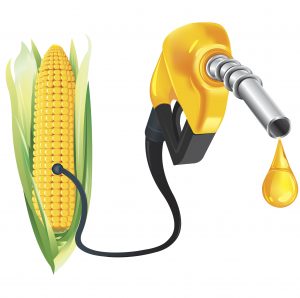
Ethanol is referred to as the first generation biofuel. This fuel source is derived from starch, sweetener, and vegetable oil. It is commercially produced by decaying corn and wheat. Plants that produce ethanol are classified as bio refineries. That’s because they use live enzymes and microorganisms to convert grain biomass into biofuels.
Start a Business in Ethanol Industry, Click Here
Most ethanol is produced from starch crops through dry or wet processing. Due to lower capital expenses, nearly 90% of ethanol plants are dry generators. Dry milling is a technique wherein corn is ground into flour and fermented in ethanol, which comprises by-products of distillers’ grains and carbon dioxide.
The wet mill mainly produces corn sweeteners, as well as ethanol and various other by-products (such as corn oil and starch). The wet mill split up the starch, protein and fiber from the corn afore handling those additives into commodities including ethanol.
Book Link: Handbook on Maize (Corn) Processing and Manufacture of Maize Products
Process of Producing Ethanol
Till date, the most important source of biofuels is sugarcane-based starch or ethanol, which are produced in large quantities and industrially in different countries. But, the last intention of biofuel production is to supply fuels with the first-rate gasoline characteristics and compatibility with existing gas distribution infrastructure from sugars extracted from lignocellulosic biomass.
Start a Business in Middle East, Click Here
Start a Business in Asia, Click Here
Bioethanol is one of the maximum stimulating biofuels due to its high quality effect at the environment. Presently, its particular comprised of raw substances containing sugar and starch. Nonetheless, numerous to be had varieties of lignocellulosic biomass, consisting of agricultural and forestry residues and herbal energy vegetation, may be used as raw substances for the production of bioethanol, power, heat, and value-added chemical compounds. Lignocellulose is a complex aggregate of carbohydrates and necessitates powerful pretreatment to acquire an enzymatic pathway to supply fermentable sugars, which can be fermented into ethanol after hydrolysis. Notwithstanding technical and economic problems, renewable lignocellulosic raw substances are low-cost raw materials which cannot be vied with the meals and feed chain, consequently promoting sustainability.
Related Video- Lucrative Business of Dual Feed Distillery (Ethanol as Bio-Fuel)
Unique modes of operation of bioprocesses had been advanced for the production of bioethanol from renewable raw substances. Furthermore, alternative bioethanol separation and purification procedures have also been majorly evolved. Seeing that lignocellulosic Feedstock is renewable and does now not enter with food vegetation, the manufacturing of bioethanol from raw materials containing lignocellulose is appealing and sustainable. Moreover, the use of bioethanol obtained from lignocellulosic feedstock is associated with a considerable decline in greenhouse gas emissions.
It can be acquired from one-of-a-kind residues or accrued straight from the forest, and its price is generally lesser than that of raw materials containing sugars or starch, requiring complete methods of agricultural improvement.
The Market Report
Starch-based ethanol is widely consumed in the United States. This type of product is a gasoline additive made from corn kernels through dry milling technology using raw materials. Ethanol is manufactured using renewable or bio-based raw materials. According to the types of raw materials, the market is divided into three segments of products, such as starch, sugar-based, and cellulose.
The starch base section had the leading retail capacity share of the worldwide marketplace in year 2016. In addition, it is estimated that it will see a compound annual growth rate of 5.8% in 2025. Starch-primarily based products are prepared from raw substances along with corn, wheat, barley, and cassava. As stated by the researchers, corn-based ethanol reduces air emissions by nearly 20%.
Start a Business in India, Click Here
However, due to its rich starch content and its ability to produce ethanol, including a high octane number and good anti-knock properties, cassava as a suitable raw material is expected to become increasingly popular in developing countries such as China and Thailand for years to come.
The most essential Cellulose or cellulosic ethanol is predicted to provide noteworthy boom potentialities in the marketplace during the estimate length. This segment is likely to grow faster during the forecast period due to the use of wood chips, corn stubble, wheat grass and husks, and other bio-waste to produce this segment.
Start a Business in Potential Countries for Doing Business, Click Here
Best Industry for Doing Business, Click Here
NPCS prepares project report for startups of all scales. The experts evaluates and studies the Ethanol from Corn Starch marketplace on an international and regional stage. The report conducts a complete assessment of marketplace struggles, restraints, type estimates, prospects, developing trends, and enterprise-tested statistics.
Business Ideas with Low, Medium & High Investment, Click Here
Looking for Most Demandable Business Ideas for Startups, Click Here
Start a Business in Africa, Click Here
AK_20Art21